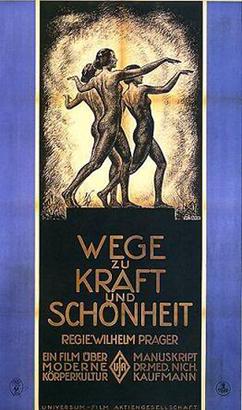Ways to Strength and Beauty facts for kids
Quick facts for kids Ways to Strength and Beauty – A film about modern physical culture |
|
|---|---|

German theatrical release poster
design: Wilhelm Tank, 1926
|
|
| Directed by | Wilhelm Prager |
| Produced by | Alfred Stern, Ufa-Kulturabteilung |
| Written by | Nicholas Kaufmann |
| Screenplay by |
|
| Starring |
|
| Music by | Giuseppe Becce |
| Cinematography |
|
| Studio |
|
| Distributed by | Oefa-Film Verleih |
| Release date(s) | 16 March 1925 (Berlin) |
| Running time | 125 minutes |
| Country | Germany |
| Language | Silent film, German intertitles |
Ways to Strength and Beauty (German: Wege zu Kraft und Schönheit) is a German silent film from 1925. It was directed by Wilhelm Prager. This long movie, about 125 minutes, was made by Ufa-Kulturabteilung in Germany. A silent film means it had no spoken dialogue, only music and text on screen.
The film was first shown in Berlin in March 1925. It quickly became very popular. It was the most important 'cultural film' in Germany at that time. A 'cultural film' was a type of documentary that aimed to educate people. It showed people how to be healthy and beautiful in a natural way. This was a big change from the busy city life in Germany during the 1920s.
What is 'Ways to Strength and Beauty' About?
This film was created by the UFA's cultural department. It shows different kinds of sport, gymnastics, and dance. It also looks at ancient Roman bathing customs. The movie wanted to show that being physically fit is just as important as being smart. It used examples from old Greek gymnasiums and ideas about personal grooming.
The film suggested that exercising outdoors could help prevent health problems. It focused on stopping bad posture from sitting too much. It also promoted health promotion for children. It was a way to encourage a healthier lifestyle, different from the fast-paced city life. City life often brought worries, little exercise, and smoking.
The film's scientific expert was a German physician named Nicholas Kaufmann. He also helped write the story. Unlike military sports, this film especially included women. For example, it showed gymnastics based on the ideas of Bess Mensendieck. It also showed sports used for everyday life, like self-defense or rescue swimming.
The movie presented the human body in a beautiful way, like art from classical antiquity. It recreated many old scenes. For its time, it showed the body very openly. Parts of the film used slow motion to clearly show how muscles work during exercises. This film was also the first time Leni Riefenstahl appeared on camera.
The Film's Six Parts
The movie is divided into six main sections. Each part focuses on a different aspect of health and beauty:
- Part one: The Ancient Greeks and the New Era
- Part two: Physical Training for Health: Hygienic Gymnastics
- Part three: Rhythmic Gymnastics
- Part four: The Dance
- Part five: Sport
- Part six: Fresh Air, Sun, and Water
Famous People and Athletes in the Film
In the fifth part, many well-known athletes from that time are featured. These include:
- High jumper Leroy Brown from the U.S. He was shown at the 1924 Summer Olympics in Paris.
- Charlie Paddock, known as America's best sprinter, during his training.
- Hubert Houben from Germany, who beat Olympic champions like Paddock and Murchison.
- H.H. Meyer, America's top hurdler.
- The Nadis family from Italy, famous for Fencing. This included Aldo Nadi, the Italian champion, and Nedo Nadi, the world champion. Nedo Nadi won many medals at the 1912 Summer Olympics and 1920 Summer Olympics.
The sixth part shows "good examples of national leaders" staying active. These include:
- Arthur James Balfour playing tennis.
- David Lloyd George playing golf.
- John D. Rockefeller playing golf when he was 85 years old.
- The Norwegian royal family skiing.
- Benito Mussolini, a leader from Italy, riding a horse.
- The German writer Gerhart Hauptmann, who won the Nobel Prize in Literature, and his wife on the beach.

